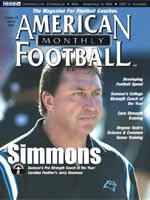Article CategoriesAFM Magazine
|
Science & Common SenseDeveloping strength and conditioning training for footballDirector of Strength & Conditioning, Virginia Tech © More from this issue Systematic resistance training and conditioning has become accepted
as a precursor to increased athletic success and an important component
for reduction of athletic related injury. Nearly all high school
and college football programs participate in some type of weight
training, speed, agility and conditioning regimens.
|
|
|||||||
| HOME |
MAGAZINE |
SUBSCRIBE | ONLINE COLUMNISTS | COACHING VIDEOS |
Copyright 2025, AmericanFootballMonthly.com
All Rights Reserved





